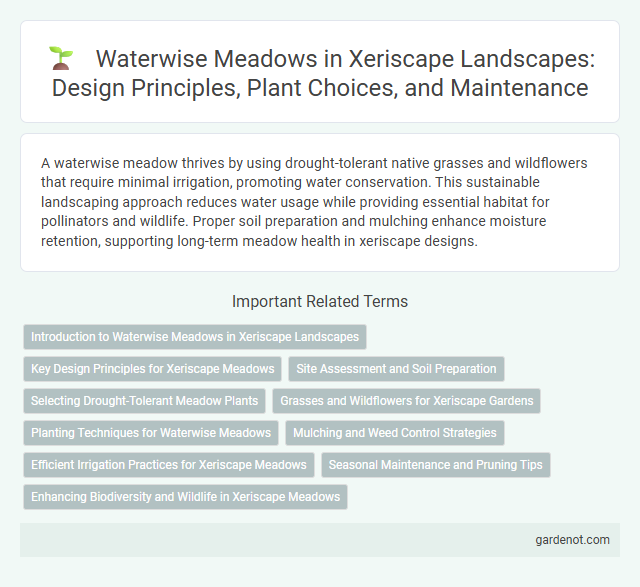A waterwise meadow thrives by using drought-tolerant native grasses and wildflowers that require minimal irrigation, promoting water conservation. This sustainable landscaping approach reduces water usage while providing essential habitat for pollinators and wildlife. Proper soil preparation and mulching enhance moisture retention, supporting long-term meadow health in xeriscape designs.
Introduction to Waterwise Meadows in Xeriscape Landscapes
Waterwise meadows in xeriscape landscapes utilize drought-tolerant native grasses and wildflowers optimized for low irrigation needs, promoting sustainable water conservation. These meadows enhance biodiversity by providing critical habitats while reducing runoff and soil erosion through deep root systems. Integrating waterwise meadows offers an eco-friendly, low-maintenance alternative to traditional lawns, aligning with xeriscape principles for efficient water use.
Key Design Principles for Xeriscape Meadows
Waterwise meadows in xeriscape design prioritize drought-tolerant native grasses and wildflowers that reduce irrigation needs while supporting local biodiversity. Key design principles include selecting deep-rooted plant species for enhanced soil moisture retention, implementing efficient drip irrigation systems, and grouping plants with similar water requirements to optimize water conservation. Incorporating mulching and soil amendments improves water infiltration and minimizes evaporation, ensuring a sustainable, low-maintenance landscape.
Site Assessment and Soil Preparation
Site assessment for a waterwise meadow involves analyzing soil texture, drainage, sunlight exposure, and native vegetation to ensure optimal plant selection and water efficiency. Soil preparation requires amending the soil with organic matter to improve structure, nutrient content, and moisture retention, while avoiding excessive tilling that disrupts soil ecosystems. Accurate evaluation of slope and watershed patterns supports effective water management, reducing irrigation needs in xeriscape landscaping.
Selecting Drought-Tolerant Meadow Plants
Selecting drought-tolerant meadow plants for a waterwise xeriscape involves choosing native grasses, wildflowers, and perennials adapted to low water conditions. Species such as Blue Grama grass (Bouteloua gracilis), Purple Coneflower (Echinacea purpurea), and Blanketflower (Gaillardia pulchella) thrive with minimal irrigation. These plants enhance soil moisture retention and reduce water consumption, promoting sustainable landscape management.
Grasses and Wildflowers for Xeriscape Gardens
Waterwise meadows in xeriscape gardens feature drought-tolerant grasses like blue grama, buffalo grass, and fescue that thrive with minimal irrigation. Native wildflowers such as black-eyed Susan, purple coneflower, and blanketflower provide vibrant color and support local pollinators while conserving water. Integrating these plants enhances soil health, reduces runoff, and creates sustainable landscapes tailored to arid climates.
Planting Techniques for Waterwise Meadows
Waterwise meadow planting techniques emphasize selecting drought-tolerant native grasses and wildflowers to create resilient, low-water landscapes. Utilizing deep-rooted plants and incorporating soil amendments improves moisture retention and soil health, reducing irrigation needs. Strategic spacing and layering optimize sunlight exposure and airflow, promoting vigorous growth and minimizing water demand.
Mulching and Weed Control Strategies
Waterwise meadow mulching utilizes organic materials such as wood chips or straw to retain soil moisture, reduce evaporation, and regulate soil temperature, essential for xeriscape success. Effective weed control in xeriscape meadows combines pre-emergent herbicides with manual removal and dense, drought-tolerant planting to minimize competition for water. Mulching also suppresses weed germination by blocking sunlight, supporting sustainable water conservation in dry landscapes.
Efficient Irrigation Practices for Xeriscape Meadows
Efficient irrigation practices for xeriscape meadows prioritize deep, infrequent watering to promote drought-resistant root systems, enhancing water conservation. Utilizing drip irrigation systems minimizes evaporation and runoff, delivering precise moisture directly to plant roots. Integrating smart irrigation controllers with soil moisture sensors further optimizes water use by adjusting schedules according to real-time environmental conditions.
Seasonal Maintenance and Pruning Tips
Waterwise meadows require minimal seasonal maintenance, primarily focusing on selective pruning and removal of dead plant material to promote healthy growth. Timing pruning activities in late winter or early spring encourages vigorous new shoots while maintaining the natural aesthetic and biodiversity. Regularly thinning dense areas improves air circulation, reducing disease risks and supporting a resilient xeriscape environment.
Enhancing Biodiversity and Wildlife in Xeriscape Meadows
Xeriscape meadows designed as waterwise landscapes boost biodiversity by incorporating native, drought-tolerant plants that provide essential habitat and food sources for local wildlife. These meadows support pollinators such as bees, butterflies, and hummingbirds, while conserving water through efficient irrigation techniques and soil moisture retention. Integrating diverse plant species in xeriscape meadows fosters resilient ecosystems and enhances ecological balance in arid and semi-arid regions.
Waterwise meadow Infographic

 gardenot.com
gardenot.com